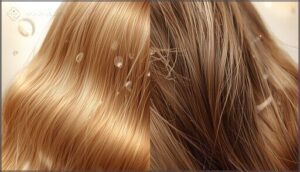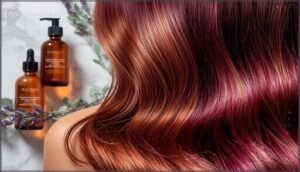This site is supported by our readers. We may earn a commission, at no cost to you, if you purchase through links.
Your hair doesn’t come with a color-change timer, yet most people stick to arbitrary schedules that ignore what their strands actually need. The truth is, dyeing frequency isn’t one-size-fits-all—your hair’s porosity, texture, and current condition act as biological gatekeepers that determine how often you can safely reapply dye.
Someone with thick, low-porosity hair might breeze through monthly color sessions while a friend with fine, chemically-damaged strands watches their hair snap off at the same pace. Professional colorists see the consequences of ignoring these signals daily: brittle ends, accelerated fading, and scalp irritation that compounds with each application.
Understanding your hair’s unique tolerance means you can refresh your color confidently without sacrificing the health and integrity of every strand.
Table Of Contents
- Key Takeaways
- How Often Should I Dye My Hair?
- Does Hair Dye Type Change Frequency?
- How Does Hair Health Impact Dyeing?
- What About Root Touch-Ups and Grays?
- At-Home Vs. Salon Dye Frequency
- How to Maintain Color Between Dye Jobs
- Tips to Reduce Hair Dye Damage
- Enhancing and Extending Hair Color
- Frequently Asked Questions (FAQs)
- Conclusion
Key Takeaways
- Your hair’s porosity, texture, and current condition determine how often you can safely dye—not a one-size-fits-all schedule—with healthy hair typically handling color every 4-8 weeks while damaged strands need longer recovery periods.
- Dye type drastically changes your timeline: temporary colors work after every wash, semi-permanent formulas allow 2-6 week intervals, while permanent dyes demand 6-8 weeks between full applications to prevent cumulative damage.
- Root touch-ups can happen every 4 weeks when regrowth shows, but you’ll stretch appointments to 3-6 months by choosing low-maintenance techniques like balayage, shadow roots, or gray blending that work with your natural growth.
- Professional salon formulas cause less damage than box dyes because colorists customize developer strength and ammonia levels to your specific hair needs, then apply bond-building treatments that at-home kits can’t match.
How Often Should I Dye My Hair?
You’ve probably heard conflicting advice about how long to wait between color appointments. The truth is, there’s no one-size-fits-all answer—it depends on your hair’s condition, the type of dye you’re using, and your personal color goals.
Let’s break down the key factors that determine your ideal dyeing schedule.
Recommended Wait Time Between Dyes
While you might be keen to refresh your color, most experts recommend waiting 4 to 6 weeks between full dye jobs to maintain hair health between dyes. This recommended time between dye jobs allows your scalp sensitivity to settle, prevents dye build-up, and gives your hair’s natural oils time to bounce back.
To minimize damage, space your dye applications appropriately. Hair dyeing frequency depends on avoiding breakage while keeping your color vibrant.
Factors Affecting Dye Frequency
Hair porosity, dye chemistry, and your hair’s baseline condition all influence how often you can safely schedule dye jobs. Textured or highly porous hair absorbs and releases pigment faster, sometimes requiring extended intervals between applications. Meanwhile, stronger oxidative formulas—especially those with ammonia or high-peroxide developers—demand longer breaks to prevent cumulative damage.
Healthy hair, however, can generally handle dyeing every 4-8 weeks, depending on the dye. Your maintenance habits, like frequent shampooing or heat styling, also affect hair health guidelines and overall hair dyeing frequency.
Signs You’re Coloring Too Often
When hair dye frequency crosses the line, you’ll notice fiber damage like increased hair breakage and hair brittleness—strands snap more easily and feel straw-like. Color fading accelerates between appointments, and texture changes leave hair coarse or unmanageable.
Scalp irritation, including redness or itching, signals that hair dye damage is accumulating faster than your hair health can recover, meaning it’s time to extend your intervals.
Does Hair Dye Type Change Frequency?
Yes, the type of hair dye you use makes a huge difference in how often you can safely recolor. Not all dyes work the same way—some barely touch your hair’s structure, while others completely transform it with stronger chemicals.
Let’s break down each type so you know exactly how long to wait between applications.
Temporary Hair Dye Guidelines
Looking for a quick color switch without the long-term commitment? Temporary dyes deliver instant color vibrancy through application methods like sprays and chalks that sit right on your hair’s surface. Here’s what makes them different:
- You can reapply after every wash if there’s no scalp sensitivity
- Most formulas rinse out in one shampoo, making washout ease their superpower
- They’re perfect as a temporary root touchup between permanent sessions
- Product longevity rarely exceeds a few days, ideal for special events
Since temporary dyes don’t penetrate your hair shaft like semipermanent hair color or demipermanent color, hair dye frequency isn’t really a concern—you won’t see the structural damage or hair color fading issues that come with oxidative formulas.
Semi-Permanent Dye Timing
Generally, you can dye your hair with semipermanent color every 2–6 weeks, depending on wash frequency and how quickly the pigment fades. Since formulation differences mean some semipermanent hair dye lacks ammonia, reapplication intervals are more flexible than with permanent color. Faster fading rates occur when you shampoo often, so hair condition and coloring hair frequency should guide your timing.
| Factor | Weekly Use | Monthly Use |
|---|---|---|
| Wash Frequency | Faster fade after 2–3 washes | Slower fade, 4–6 weeks visible |
| Hair Health | Risk of dryness increases | Better moisture retention |
| Recommended Interval | As needed per wash count | Every 4–6 weeks typical |
Demi-Permanent Dye Scheduling
You’ll generally schedule demipermanent color every 6–8 weeks, though root touch-ups can happen closer to 4 weeks when regrowth shows. Lifestyle factors—like frequent shampooing or heat styling—shorten intervals, and formulation sensitivity means spacing applications protects your hair’s integrity while managing the recommended time between dye jobs.
Because demipermanent colors deposit pigment without heavy lightening, color longevity balances with damage prevention better than permanent formulas.
Permanent Hair Dye Recommendations
Permanent hair dye demands the longest intervals—ideally 6–8 weeks between full applications—because oxidative stress reduction matters for hair health and structural damage control.
Root TouchUps Frequency can shift to 4 weeks when regrowth contrasts sharply, yet color overlapping risks intensify if you re-dye sooner.
Spacing permanent hair color sessions protects against dermatological side effects and cumulative hair damage while managing the chemical load on each strand.
How Does Hair Health Impact Dyeing?
Your hair’s current condition is the biggest factor in determining how often you can safely color it. Healthy hair can handle more frequent treatments, while damaged or fragile strands need extra time between sessions.
Let’s look at the specific ways your hair’s health affects your dyeing schedule.
Effects of Frequent Dyeing
When you dye your hair more than five times, you’re putting serious stress on each strand. Fiber damage happens because the chemicals strip moisture—one study found repeated dyeing cut water content nearly in half. That’s a recipe for dry, brittle hair that snaps at the slightest tug.
Dyeing your hair more than five times can cut moisture in half, leaving strands dry, brittle, and prone to breaking
- Breakage risk: Your hair’s protective cuticle weakens with every chemical session, leaving strands vulnerable to splitting and breaking off.
- Scalp irritation: Ingredients like PPD can trigger redness, itching, or even painful reactions after repeated exposure.
- Hair loss: Severe allergic reactions sometimes lead to shedding—one case reported 90% scalp hair loss after frequent use.
- Long-term health: Decades of regular dyeing may increase exposure to ingredients flagged by health agencies for potential risks.
- Chemical effects on hair: Permanent dyes break down protein bonds, reducing tensile strength by up to 40% and roughening the surface considerably.
Hair Type and Porosity Considerations
Your hair’s porosity level acts like a gatekeeper. Tightly packed cuticles in low-porosity hair resist dye uptake but hold color longer, while high-porosity strands (especially bleached or curly hair) soak up pigment fast yet fade quickly.
Fine hair shows texture vulnerability under chemical stress, so you’ll need longer breaks between sessions than someone with thick, coarse strands that bounce back easily.
Pre-existing Hair Damage
Already struggling with breakage or split ends? Think of damaged hair like cracked pottery—another round of permanent dye can shatter what’s left.
Your cuticle layers are already compromised, making damage assessment critical before your next color. Protein treatments days before dyeing help repair the cortex, while hydration importance can’t be overstated.
Consider dye alternatives like semi-permanent formulas, and extend intervals to 8+ weeks minimum for proper cuticle repair and hair health recovery.
What About Root Touch-Ups and Grays?
Root touch-ups and gray coverage don’t follow the same timeline as full-color applications. Your hair’s natural growth rate and the contrast between your roots and your dyed color determine how often you’ll need attention.
Let’s look at timing strategies that keep your color fresh without overprocessing your strands.
Root Regrowth Timing
How quickly do your roots reveal themselves after a fresh dye job? On average, scalp hair grows about half an inch each month, making root touchups necessary every four to six weeks for uniform hair color maintenance.
If you’re covering grays or sporting high-contrast shades, you’ll likely notice regrowth visibility around the three-week mark. Individual characteristics like hair thickness and growth variation affect when practical thresholds demand your next root touchup.
Covering Gray Hair Effectively
When you’re managing significant gray—especially beyond 75%, permanent hair dye delivers the most reliable gray coverage efficacy. Stubborn white strands need stronger formulations to penetrate resistance and formulation challenges; that’s why professionals often recommend double-neutral shades.
Health and safety studies show conditioning dyes can actually improve hair quality while masking gray.
If full coverage feels too high-maintenance, blending and shifting techniques offer a softer, less frequent alternative.
Low-Maintenance Color Options
Beyond blending, several low-maintenance color options let you stretch your salon visits to three or even six months. Balayage benefits include hand-painted gradients that soften regrowth, while shadow roots and natural shades within two levels of your base keep new growth looking intentional. Partial highlights around your face refresh dimension without full recoloring, and gray blending techniques weave silver strands into multi-tonal patterns that grow out gracefully.
Smart strategies to extend your appointments:
- Balayage and lived-in highlights allow 12+ weeks between visits because the gradient minimizes visible lines
- Shadow roots blur the demarcation between natural hair and lightened sections, making several centimeters of regrowth less noticeable
- Gray blending requires maintenance every 8–12 weeks instead of the 3–5 week intervals for full coverage
- Partial highlights focusing on crown and face frame can double the time between full-color visits when alternated with glosses
- Colors within 2–3 shades of your natural base extend maintenance intervals to 8–12 weeks by reducing contrast
At-Home Vs. Salon Dye Frequency
Where you color your hair makes a bigger difference than you might think. At-home box dyes and salon treatments aren’t created equal, and that affects how often you can safely reach for the color bottle.
Let’s break down what sets them apart so you can make smarter choices for your hair.
Differences in Product Strength
Box dyes often pack a punch with higher ammonia levels and stronger developer volume—usually 20–30 volume compared to salon options—because they’re built to work on any hair type. That one-size-fits-all approach can mean more damage risk, especially with repeated use.
Here’s how at-home and professional formulas stack up:
| Feature | At-Home Box Dye | Professional Salon Dye |
|---|---|---|
| Developer Volume | Fixed 20–30 volume | Customizable 5–40 volume |
| Ammonia Levels | Higher, consistent strength | Lower or ammonia-free options |
| Conditioning Agents | Basic protective systems | Bond-building complexes |
Professional colorists can dial down pigment density and oxidative strength to match your hair’s actual needs, reducing the likelihood of over-processing.
Protective Ingredients and Application
Salon formulas weave in protective ingredients like argan oil and silicone to shield your strands during the coloring process. These conditioning treatments help reduce protein loss and breakage—studies show argan oil in post-dye care cuts damage considerably compared to basic formulas.
Ammonia alternatives and bond-building complexes keep your hair health on track, especially when application techniques involve careful sectioning and timing.
| Ingredient Type | Purpose |
|---|---|
| Argan Oil | Reduces protein loss during dyeing |
| Silicones | Protects against heat and mechanical damage |
| Ammonia-Free Systems | Minimizes scalp irritation and fiber stress |
Professional Colorist Advice
When you book salon consultations, professional colorists assess your hair health before mixing custom blending formulas suited to your strand strength. They use sophisticated techniques like balayage or color correction to minimize overlap damage. Their damage prevention protocols—like strategic sectioning and timed application—mean you can dye your hair safely every 6-8 weeks without compromising integrity.
| Salon Advantage | Why It Matters |
|---|---|
| Personalized Assessment | Evaluates current damage and porosity levels |
| Custom Formulation | Matches developer strength to your hair type |
| Sophisticated Techniques | Reduces chemical overlap and breakage risk |
| Damage Prevention Plans | Preserves long-term hair health and color |
How to Maintain Color Between Dye Jobs
Getting the color you want is only half the battle—keeping it vibrant between appointments is where the real work happens. The good news is that a few simple habits can extend your color’s life and protect your hair at the same time.
Let’s look at two key areas that make the biggest difference in maintaining your freshly dyed shade.
Avoiding Over-Shampooing
Every hair wash strips a bit of color—think of it like rinsing watercolor paint off a canvas. To keep your shade vibrant longer, aim for washing just 2–3 times per week. Here’s how to dial back without sacrificing Scalp Health:
- Switch to cool Water Temperature; hot water lifts the cuticle and releases pigment faster.
- Choose gentle, color-safe Product Formulation over harsh clarifying shampoo.
- Try co-washing or dry Shampoo Alternatives between full washes.
- Reduce overall Wash Frequency to minimize detergent exposure.
- Balance your hair care routine with your hair’s actual cleanliness needs.
Limiting Heat Styling
Flat irons and curling wands deliver thermal insult that accelerates color fading and weakens your strands. Research shows temperatures above 150°C denature keratin and crack the cuticle—exactly where your dye lives.
Limit heat styling to 1–2 times per week and always apply a heat protectant beforehand; formulations reduce moisture loss and buffer against damage. Lower your temperature thresholds, watch for heat damage signs like brittleness, and you’ll preserve both your color and your hair’s integrity.
Tips to Reduce Hair Dye Damage
Protecting your hair from dye damage doesn’t mean you have to skip color altogether. With the right approach, you can keep your strands strong and healthy between appointments.
Here are three essential strategies to minimize damage every time you color.
Conditioning and Moisturizing
Deep conditioning treatments every 1–2 weeks work wonders for color-treated hair that’s been compromised by chemicals. Post-dye conditioning with acidic pH products helps reseal lifted cuticles and accelerate recovery.
Here’s your damage-control routine:
- Apply conditioning masks packed with emollients and proteins immediately after coloring
- Use leave-in conditioners to maintain hair moisture between washes
- Choose products with cationic surfactants that improve cuticle alignment
- Keep moisturizing routines consistent to reduce breakage and restore softness
Heat Protection Methods
Thermal damage starts above 180 °C on dry hair, so heat protection for hair isn’t optional—it’s survival gear for your color investment.
Product formulations with silicones or polymers create a protective film that distributes heat evenly and reduces cuticle cracking. Application practices matter: spray evenly, let it dry, then style below 200 °C.
Herbal protectants with antioxidants offer bonus moisture retention, especially for chemically treated hair types facing compounded hair damage risks.
Regular Hair Treatments
Beyond heat shields, your hair needs regular reinforcement to bounce back from color chemistry. Salon conditioning every 2–4 weeks keeps color-treated hair elastic and strong, while at-home masks once or twice weekly fight dryness between visits.
Bond-building treatments rebuild broken internal links from bleach or permanent dye.
For textured or compromised hair, oil treatments 2–3 times weekly lock in moisture and support long-term hair maintenance without constant re-dyeing.
Enhancing and Extending Hair Color
You don’t have to choose between vibrant color and healthy hair. A few targeted strategies can help you keep your color looking fresh while reducing how often you need to redye.
Here’s how to make your color work harder for you.
Using Hair Toning Glosses
Toning glosses refresh your hair color and boost shine between full dye jobs. Semi-permanent gloss formulas are gentler on your hair health than permanent dyes, making them ideal for color-treated hair that needs a pick-me-up.
You can usually reapply every 4–6 weeks, which helps maintain vibrancy without overdoing chemical exposure. Your hair type and porosity also shape gloss reapplication frequency—fine strands may need longer intervals.
Scalp Scrubs and Clarifying Shampoos
While glosses keep color fresh, regular scalp exfoliation and strategic clarifying shampoos support long-term hair health and color retention. Here’s how to balance both:
- Exfoliation Frequency: Scrub your scalp every 1–2 weeks to remove buildup without irritation
- Scrub Effects: Proper exfoliation boosts scalp hydration by over 76% and improves hair density
- Clarifying Shampoos: Use these once every 1–2 weeks on color-treated hair to prevent product residue
- Color Fading: Strong surfactants lift pigment, so choose color-safe clarifying formulas
- Ingredient Considerations: Avoid harsh sulfates; opt for gentler acids like glycolic or salicylic
Wait at least 7 days after dyeing before your first clarifying hair treatment—this lets pigment stabilize. Pair clarifying shampoos with deep conditioning to offset drying effects and maintain your hair’s integrity between color appointments.
Embracing Gray Blending Techniques
Once you’ve cleared buildup, consider whether you need full gray hair coverage at all. Gray blending techniques—think strategic highlights and lowlights—soften the line between natural silver and pigmented strands, creating a low-maintenance hair color that grows out gracefully.
This approach reduces your dye frequency to every few months instead of rigid 4–6 week cycles, letting you embrace a modern, individual look that’s easier on your hair.
Frequently Asked Questions (FAQs)
Can hair dye cause allergic reactions over time?
Yes, repeated chemical exposure can sensitize your skin to dye allergens like PPD. While not everyone develops reactions, allergic contact dermatitis may emerge after multiple uses, causing skin irritation or swelling.
Does diet or nutrition affect hair dye results?
Nutrient deficiencies in iron, B12, and copper can weaken hair shaft structure and reduce melanin synthesis, making color uptake less predictable.
Better systemic health through balanced nutrition promotes stronger, more resilient hair that holds dye evenly.
Is it safe to dye hair during pregnancy?
Most experts consider it usually safe once organogenesis is complete. Low fetal exposure risk makes standard dye application compatible with pregnancy trimester timing and breastfeeding considerations. However, occupational dye exposure warrants caution.
How does chlorine affect freshly dyed hair?
Chlorine strips color-treated hair of natural oils, accelerates dye fading, and can cause structural damage like dryness and breakage.
Blonde shades may develop greenish discoloration from chlorine interacting with dissolved metals in pool water.
Can I dye hair after keratin treatments?
You can, but wait at least seven to fourteen days post-keratin to avoid stripping the treatment.
Color beforehand works better—let keratin seal your dye, extending vibrancy and smoothness while protecting hair health.
Conclusion
Think of your hair as a canvas that needs time to recover between masterpieces. How often should I dye my hair? The answer lives in your strands’ condition, not a calendar. Listen to what your hair tells you through its texture, elasticity, and shine.
When you align your coloring schedule with your hair’s biological needs rather than arbitrary timelines, you don’t just preserve color—you protect the foundation that makes every shade look its best.
- https://www.healthline.com/health/beauty-skin-care/how-often-can-you-dye-your-hair
- https://usbeautybazaar.com/blogs/blog-posts/ideal-hair-dyeing-schedule-explained
- https://www.styleseat.com/blog/how-often-can-you-dye-your-hair/
- https://pmc.ncbi.nlm.nih.gov/articles/PMC11417257/
- https://hairstory.com/blogs/news/how-often-can-you-dye-your-hair-safely












